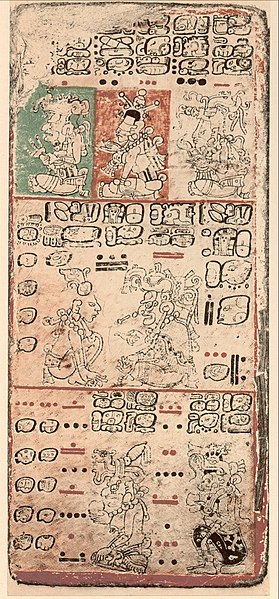VASES
 |
| Mayan vase depicting scribes. (Source.) |
Additionally, some Mayan vases depict scribes making and writing on codices. We learn more about how Mayans made codices from these images.
SPANISH MISSIONARIES
Sixteenth-century Spanish missionaries in Central America deliberately destroyed codices they found. They were concerned that the presence of these books would distract the would-be converts or remind them of their "pagan past." Most codices sent back to Europe were damaged or discarded en route.Additionally, Spanish book-making and the Spanish alphabet took over Mayan paper- and book-making processes. The missionaries placed great importance on the printing press to make books for proselyting.
1940s OBSERVATIONS
 |
| Von Hagen with his wife. (And a vicuña.) (Source.) |
CODICES
 |
| A page from a Mayan codex. (Source.) |
We also learn from the surviving codices the page formatting. Long pages were folded to create many pages. The longest page of the four surviving codices measures over 22 feet, folding into 112 pages.
CONCLUSION
We still have much to learn about codices, but vases, the visitation of Spanish missionaries, modern observations, and surviving codices teach us much about the content, format, construction, and history of Mayan codices.The Construction of the Codex...
Maya codices
Barkcloth
So what exactly are Mayan codices? Are they stories? Is it their language? Is it a code?
ReplyDeleteWhether it is or not, this post did remind me of the time I read the DaVinci code. While I don't know if DaVinci really did encode his art to convey hidden messages about the Holy Grail, I do wonder if ancient civilizations included codes in their language and art? And if so, what was the purpose? I often contemplate the people living prior to the construction of the tower of Babel. How advanced was their civilization? What artifacts do we still have from them? Did they leave clues as to the kind of knowledge they possessed?
I find it fascinating that they folded their codices instead of rolling it like parchment. To what extent did the form affect the content?
ReplyDeleteA codex is just a book. :) An old book in the format of modern books--pages, binding, etc.
ReplyDelete@Sam - I don't know much, but I do think that they might have had more writing space if they had been rolled, because of margins and whatnot. But maybe if it was rolled, they wouldn't have been able to write on both sides?
When we had the presentation by BYU's special collections, they said that pages allowed readers to find a specific passage and read a single portion of a work, a freedom that scrolls did not encourage. Could that have made their knowledge more adaptable to a given situation?
ReplyDeleteThe fact that books were burned seems like such a bad thing when you realize just how much of history is contained within them. On the other hand, it also organizes and solidifies knowledge as a culture understands it, so burning books has a way of clearing the boards for new thinking.
ReplyDelete@Catherine-Wouldn't a folded, accordion-style book have the same limitations as a rolled scroll?
ReplyDelete